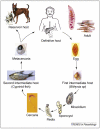Opisthorchis viverrini: an underestimated parasite in world health
- PMID: 18930439
- PMCID: PMC2635548
- DOI: 10.1016/j.pt.2008.08.011
Opisthorchis viverrini: an underestimated parasite in world health
Abstract
Infection with Opisthorchis viverrini and its associated cholangiocarcinoma (CCA) is an underestimated problem in the Mekong region of Southeast Asia, despite the widespread use of praziquantel and health education measures for parasite control. Although data from Cambodia, Laos and Vietnam are rare, data from Thailand often show wide-ranging variability in epidemiological parameters, including human morbidity and the prevalence and incidence of CCA. The recent discovery of high levels of population genetic variability in O. viverrini in different wetlands in Thailand and Laos, which indicates the presence of sibling species, suggests that we have underestimated the complexity of this epidemiological situation. Future research should determine the relationship between the genetic variability of O. viverrini and patterns of opisthorchiasis-related disease.
Figures


References
-
- WHO . World Health Organisation-United Nations Program on HIV/AIDS. 2007. AIDS epidemic update.
-
- Sithithaworn P, Haswell-Elkins M. Epidemiology of Opisthorchis viverrini. Acta Trop. 2003;88:187–194. - PubMed
-
- Petney TN. Environmental, cultural and social changes and their influence on parasite infections. Int. J. Parasitol. 2001;31:919–932. - PubMed
-
- Hotez PJ, et al. Control of neglected tropical diseases. N. Engl. J. Med. 2007;357:1018–1027. - PubMed
Publication types
MeSH terms
Substances
Grants and funding
LinkOut - more resources
Full Text Sources

